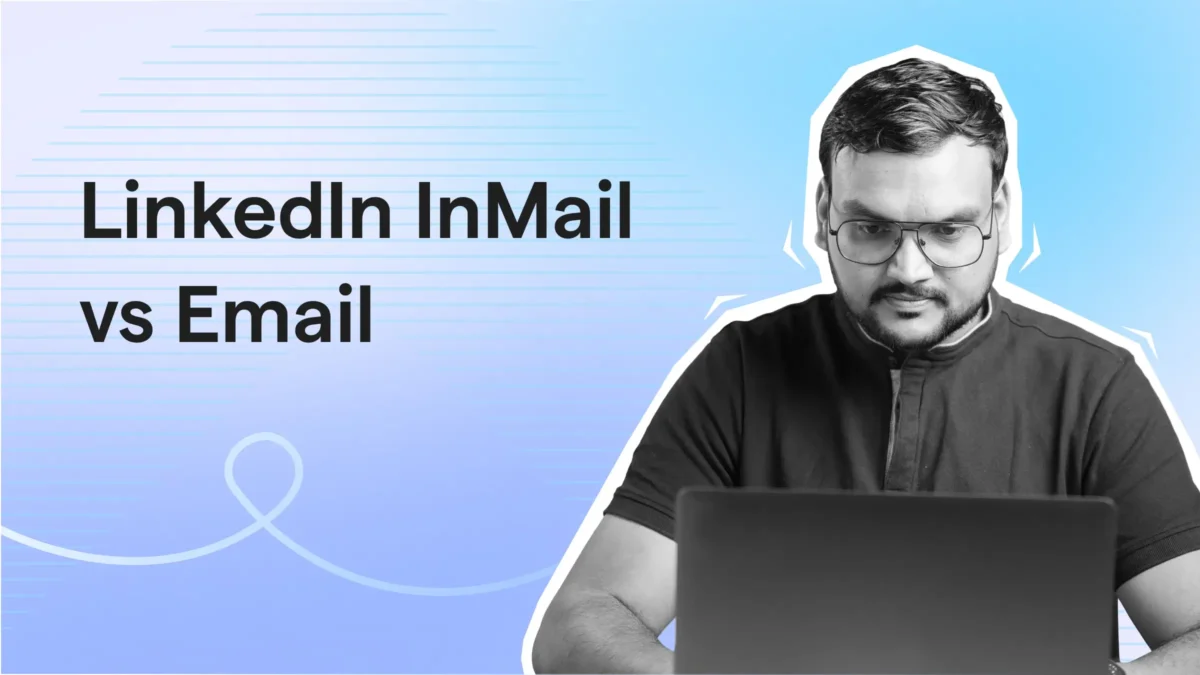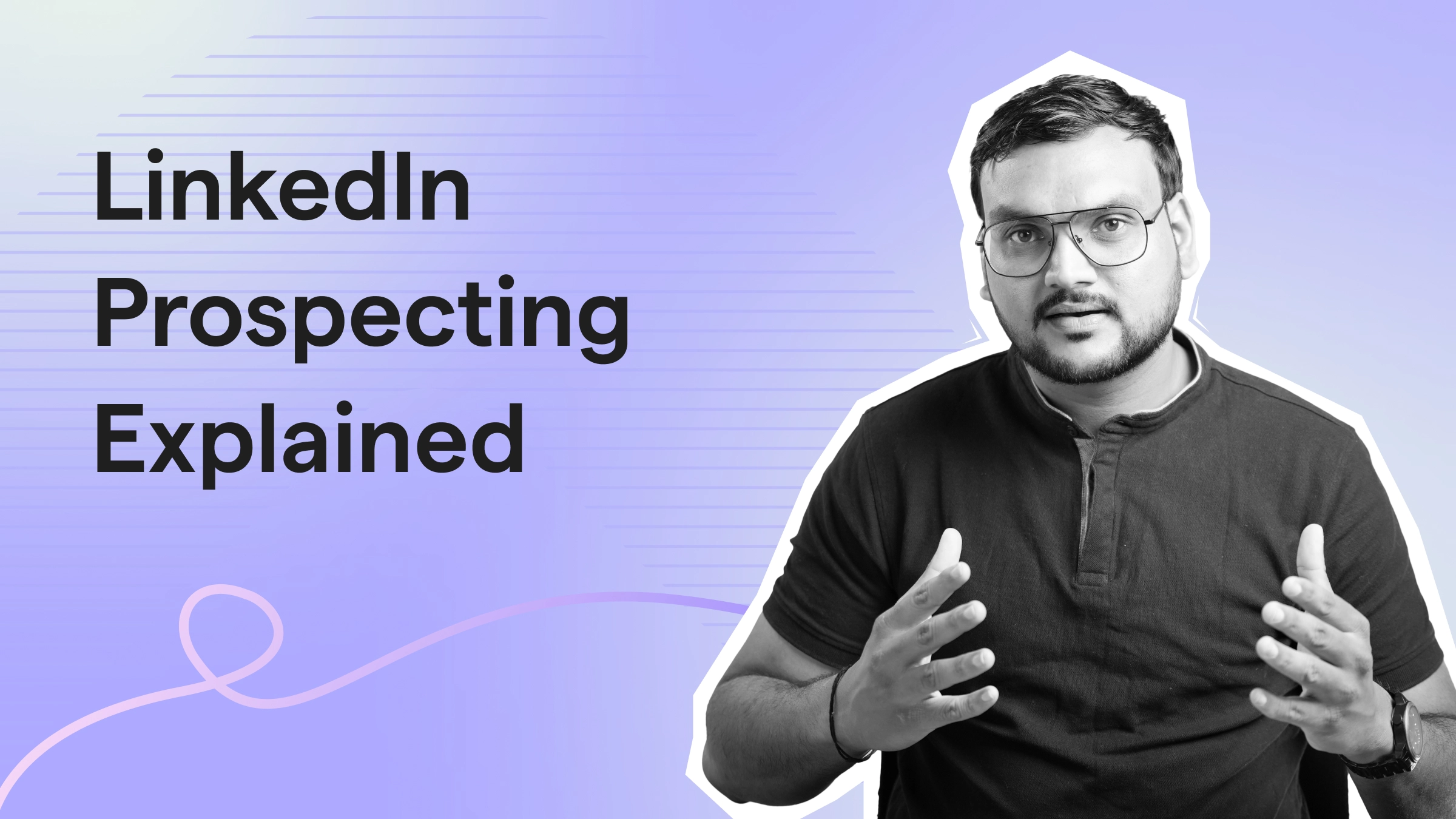Contents
Let’s be honest, picking the right outreach channel can sometimes feel like a gamble.
You’ve probably wondered more than once:
Should I send a LinkedIn InMail or just go with a good old email?
Both are popular for outreach, but they have their own strengths and weaknesses.
What if you choose the wrong one?
That could mean fewer replies, wasted time, and missed pipeline targets.
That’s exactly why I wrote this blog.
In this blog, I’ll walk you through LinkedIn InMail vs Email, and compare them across the only things that actually matter in 2025:
- Which one gets more replies?
- When should you use each one?
- And most importantly, which one actually works better for sales and marketing today?
Let’s break it down.
LinkedIn InMail Vs Email: TOC
TL;DR: Which One is Better for Sales and Marketing? InMail vs Email
If you’re short on time, then let me tell you which is best for what:
- Choose InMail if you want native outreach in LinkedIn
- Go with Email for features such as easy scalability and high personalization options
Now, to make things even easier, here’s a quick comparison of LinkedIn InMail vs Email based on cost, reach, scalability, and overall effectiveness for sales and marketing outreach in 2025.
| Category | InMail | Email Outreach |
|---|---|---|
| Cost | Paid (starts at $29.99/month) | Low cost (many tools offer free trials) |
| Reach | Only LinkedIn users | Anyone with a valid email address |
| Follow-ups | Only if the recipient replies | Unlimited follow-ups (manual or automated) |
| Automation | Limited (basic scheduling only) | Fully automatable with outreach tools |
| Personalization | Based on LinkedIn profile data | Fully customizable with merge tags, AI, and dynamic fields |
This was just the quick version.
If you’re curious about how LinkedIn InMail and Email Outreach really work, keep scrolling 👇
What is LinkedIn InMail?
LinkedIn InMail lets you message someone on LinkedIn without sending a connection request first.
You’ll need a LinkedIn Premium or Sales Navigator plan to use it, and you only get a limited number of InMail credits each month.
Here’s how InMail credits work:
One credit is charged for every message you send.
However, if the person replies, LinkedIn gives that credit back.
If they ignore it? That credit’s gone.
On the plus side, InMails usually appear higher in a LinkedIn inbox, so they’re more visible than regular messages.
But if you want to refill your credits, they’re not cheap. And unless the person replies, you can’t send a follow-up, which makes nurturing harder.
Also read: Cold Email vs LinkedIn Message: What’s More Effective For Outbound Outreach?
What is Email Outreach?
Email outreach is a strategy of sending personalized, targeted emails to potential customers, collaborators, or contacts in order to achieve a specific goal.
This can be such as generating leads, building relationships, promoting content, securing backlinks, or even booking meetings.
All you need is their email address—and a tool to send it to them.
No LinkedIn Premium. No need to be connected. No platform limits.
Compared to LinkedIn InMail, email gives you way more flexibility:
- You can follow up to see whether they reply or not.
- Build full conversation threads.
- Personalize every message.
- And automate the whole sequence if you want.
And the best part?
It stays budget-friendly, even when you’re scaling outreach to hundreds or thousands of prospects.
Just one heads-up: If you don’t warm up your email account or follow email best practices, your messages could end up in spam—or worse, just ignored.
LinkedIn InMail vs Email – Feature-by-Feature Comparison
Both LinkedIn InMail and Email Outreach come with their own set of pros and cons.
So when I’m deciding which one to use, I ask myself two questions:
- What matters more for this campaign? Is it reach, cost, personalization, or scale?
- And what am I willing to trade off?
To make your decision easier, here’s a simple comparison across the things that actually matter 👇
| Feature | LinkedIn InMail | Email Outreach | Winner |
|---|---|---|---|
| Platform Access | Limited to LinkedIn and Sales Navigator | Works with any email provider or outreach tool | Email Outreach |
| Reach | Only LinkedIn users | Anyone with a valid email address | Email Outreach |
| Cost | Starts from $29.99 | Low cost, even at scale | Email Outreach |
| Personalization | Limited to profile-based tweaks | Fully customizable with merge and spintax tags and dynamic fields | Email Outreach |
| Follow-ups | Only if the recipient replies | Unlimited follow-ups, threads, sequences | Email Outreach |
| Automation & Scale | Manual or via 3rd-party LinkedIn tools | High automation is possible via tools like Saleshandy | Email Outreach |
| Visibility | Priority inbox placement in LinkedIn | Depends on deliverability & warm-up | Inmail |
| Analytics | Basic read receipts | Advanced tracking | Email Outreach |
So does that mean email outreach should be your go-to outreach channel?
Not Always!
Email outreach wins in terms of scale, cost, and flexibility, but that doesn’t mean LinkedIn InMail is useless.
If you’re targeting very active LinkedIn users or want to stand out in a crowded inbox, InMail might get you a quicker reply, especially if your profile is strong.
I often use both, depending on the type of prospect and the stage of the outreach.
When to Use LinkedIn InMail?
I usually go with LinkedIn InMail when I want my message to feel personal and platform-native.
I use LinkedIn InMail when:
- The person is very active on LinkedIn
- Don’t have their verified email address
- Keeping the conversation inside LinkedIn (like recruiters or mutual connections)
- Want to do 1:1 outreach, which doesn’t need automation
InMail is ideal when quality matters more than quantity.
When to Use Email Outreach?
Email is my go-to when I want to reach prospects quickly by keeping control over the process.
I use email outreach when:
- Targeting a larger list of prospects
- Need a budget-friendly way to scale
- Want complete control over the message, layout, and follow-ups
- Require to automate outreach sequences and track what’s working
In short, if you want to build a scalable outbound system, email outreach is a better channel to meet your requirements.
Also read: Best Email Outreach Tools To Get More Leads
What’s the Right Channel for You?
Choosing the right outreach channel can make or break your results.
That’s why I broke down both LinkedIn InMail and Email Outreach, so you can pick the one that fits your goals, budget, and target audience.
Here’s the short version:
In most cases, I recommend going with email outreach because it’s:
- Scalable and easy on the budget
- Personalizable at scale
- Fully automatable, from first touch to follow-up to booked call
But InMail still has its place.
If you’re doing hyper-personalized, 1:1 outreach, or you don’t have access to someone’s verified email, LinkedIn InMail provides results.
This is especially true for recruiters, founders, or execs who are active on LinkedIn.
My suggestion?
Use both channels when it makes sense.
The key is knowing when to use what and making each one work to your advantage.
And if you’re just getting started with email outreach?
Saleshandy’s Lead Finder can help you find and verify leads
If you already have leads, use Saleshandy for outreach. It allows you to automate, personalize, and track your entire outreach campaign — from the first email to the final reply.
LinkedIn vs Email: FAQs
1. What is the difference between InMail and LinkedIn messages?
The main difference is that InMail lets you message people you’re not connected with, while LinkedIn messages only work with your 1st-degree connections.
InMail is a paid feature that comes with LinkedIn Premium or Sales Navigator. LinkedIn messages, on the other hand, are free, but only work within your existing network.
2. Can I send InMail for free?
LinkedIn offers a one-month free trial of Premium for new users. If you enroll in that, you’ll get access to InMail at no cost during the trial.
Apart from that, there are no official ways to use InMail for free. However, if someone replies to your InMail, LinkedIn gives that credit back. which helps stretch your quota a bit.
3. Is email outreach legal?
Yes. Email outreach is legal, as long as you follow data privacy and anti-spam regulations like GDPR (in Europe), CAN-SPAM (in the US), and other local laws.
That said, it’s always better to use an outreach tool like Saleshandy, as it helps ensure your emails stay compliant by handling things like unsubscribe links, sending limits, and personalization best practices.
4. Why use email over LinkedIn?
Email gives you more control, scalability, and flexibility compared to LinkedIn.
You can personalize your messaging, automate sequences, follow up without limits, and track every open, click, and reply. Plus, email doesn’t require any premium subscription, and works outside of just one platform.
For anyone doing high-volume outreach or running structured campaigns, email is simply the more powerful (and budget-friendly) channel.







